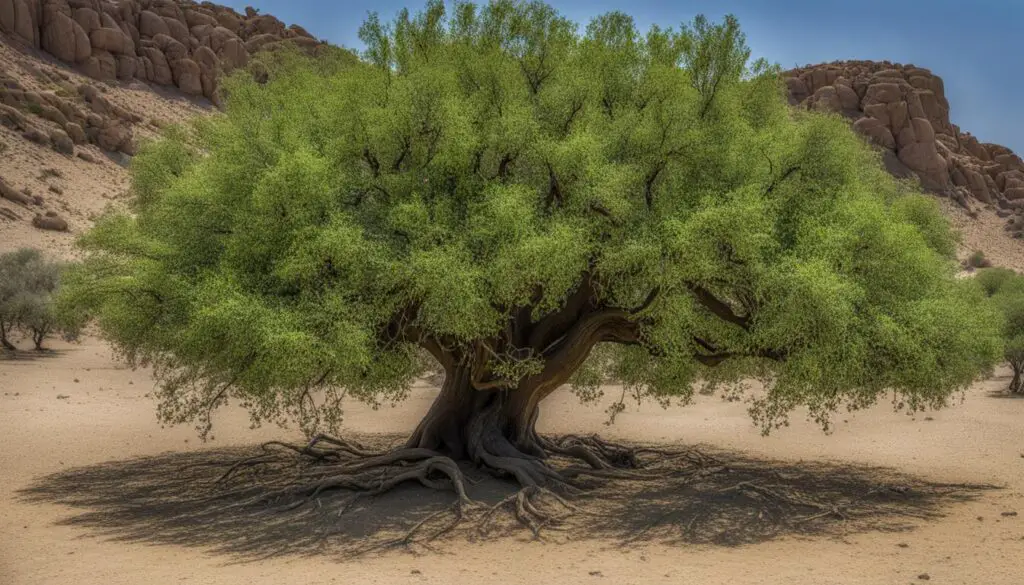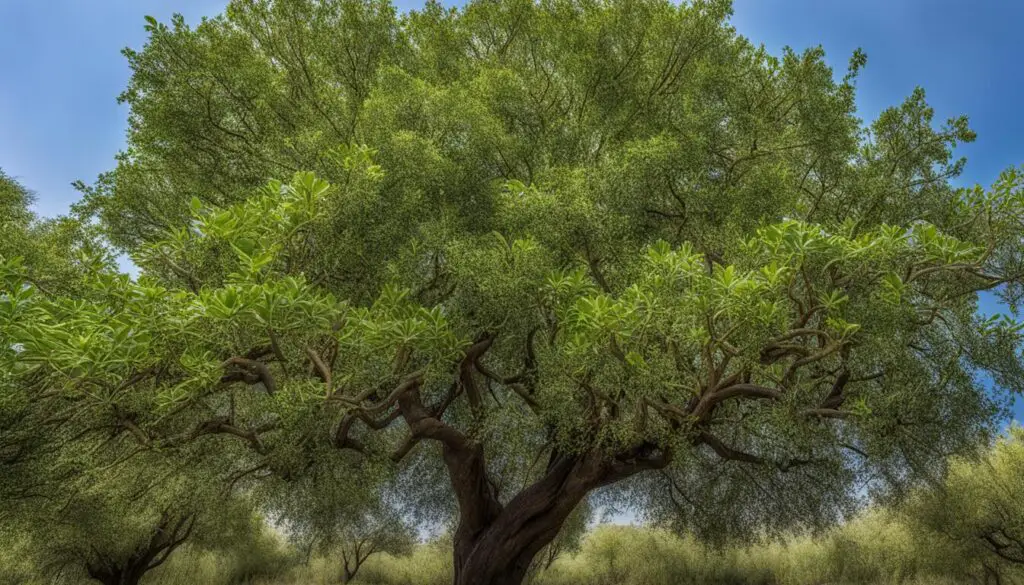Pistachios are a beloved nut known for their unique flavor and iconic split shell. But have you ever wondered if pistachios grow on trees or bushes? In this article, we will delve into the fascinating world of pistachio trees and uncover the truth behind their cultivation.
Key Takeaways:
- Pistachios are primarily grown on trees, specifically the Pistacia vera tree.
- The Pistacia vera tree is a deciduous tree native to the Middle East and Central Asia.
- Female and male trees are needed for successful fertilization, with one male tree typically utilized for every ten female trees.
- Pistachio trees produce harvestable nuts when the hull becomes loose, and the shell splits open naturally.
- The pistachio tree takes several years to reach full production, but the reward of harvesting your own fresh pistachios makes it worthwhile.
Origins of the Pistachio Tree
The pistachio tree has a fascinating history, with its cultivation dating back to ancient times. Originating from the Middle East and Central Asia, pistachios have been enjoyed as a food source for thousands of years. The earliest recorded evidence of pistachios being grown for consumption dates back to 6,750 BC. Throughout history, the cultivation of pistachio trees has evolved, leading to the development of the modern pistachio, which is now widely consumed and enjoyed around the world.
During the Roman era, the cultivation of pistachios was mentioned by Pliny the Elder in Italy around 35 AD. The cultivation techniques and knowledge surrounding pistachio farming continued to advance over the centuries, resulting in improved varieties that are more convenient to eat.
Today, pistachios are commercially grown in various countries, including the United States, which is known for its vast pistachio orchards. Commercial pistachio cultivation requires specific conditions to thrive. These trees are typically cultivated in regions with USDA hardiness zones 8 to 10, characterized by desert-like conditions with hot summers and a tolerance for drought and saline soil.
The pistachio orchards in these regions provide an optimal environment for the trees to flourish and produce abundant crops of the delicious and nutritious nuts.
Planting and Growing Pistachio Trees
Proper planting and care are essential for the successful growth of pistachio trees. Follow these guidelines to ensure your pistachio trees thrive and produce a bountiful crop.
1. Planting
Pistachio trees should be planted in the spring to give them time to establish themselves through the summer. When selecting a location, choose a spot with full sun exposure, as pistachio trees require at least six hours of direct sunlight each day. The soil should be well-draining to prevent waterlogging.
When planting, dig a hole that is as deep as the root ball and twice as wide. Place the tree in the hole, ensuring that the bud union is above the soil surface. Backfill the hole with the excavated soil, gently firming it around the roots. Water the newly planted tree thoroughly.
2. Care
Pistachio trees require regular watering, especially during the first year. However, ensure that the soil is well-drained to avoid the risk of root rot. Mulching around the base of the tree can help conserve moisture and inhibit weed growth.
During the first year, minimal fertilization is required. Slow-release fertilizer can be applied in subsequent years, following the manufacturer’s instructions. Pruning should be done during the dormant season to remove dead or diseased branches and to control the tree’s shape and size.
Pistachio trees typically take around 7 to 8 years to produce their first crop of fruit. Full production may take up to 15 years, so patience is required. It is important to note that pistachio trees are biennial bearers, meaning they produce a small crop one year and a larger crop the next.
3. Pest and Disease Management
Pistachio trees can be susceptible to pests and diseases such as scale and stinkbugs. To prevent infestations, monitor your trees regularly and implement appropriate pest control measures when necessary. Insecticidal soap can be used to control infestations, but be careful not to harm beneficial insects.
4. Pistachio Tree Lifespan
The lifespan of a pistachio tree can vary depending on various factors, including proper care and environmental conditions. On average, a well-maintained pistachio tree can live for several decades, providing you with a consistent harvest of delicious nuts.
By following these tips for pistachio tree care and cultivation, you can create a thriving orchard that yields an abundance of nutritious and flavorful pistachios.
Interesting Facts About Pistachio Trees
Pistachio trees have some fascinating characteristics. They are unisex trees, with each tree bearing either male or female flowers. In orchards, one male tree can fertilize up to ten female trees. The tree’s flowers appear in early summer, and the drupe’s original green color gradually turns reddish-brown as it matures.
The outer hull begins to dry out and loosen by September or October, and the hard outer shell of the seed splits open with a distinctive popping sound when fully mature. This split can allow insects and mold to infest the seed if not harvested promptly. Commercial farmers often use mechanical agitators to shake the trees, ensuring a quick and efficient harvest.
The pistachio nut itself is approximately 45.3% fat, 27.2% carbohydrates, and 20.2% protein. It is a valuable source of healthy fats and nutrients.

| Characteristic | Percentage |
|---|---|
| Fat | 45.3% |
| Carbohydrates | 27.2% |
| Protein | 20.2% |
The Different Types of Pistachio Trees
While Pistacia vera is the main commercially grown pistachio tree species, there are other species within the Pistacia genus. These species, however, are not typically cultivated for commercial food production. The table below showcases some of the recognized pistachio tree species:
| Species | Common Name | Uses |
|---|---|---|
| Pistacia aethiopica | African mastic tree | Carpentry, rootstocks, and oil |
| Pistacia atlantica | Atlas pistachio | Carpentry, rootstocks, and oil |
| Pistacia chinensis | Chinese pistachio | Ornamental tree, rootstocks |
| Pistacia eurycarpa | Quds pistachio | Rootstocks |
| Pistacia falcata | Fruit-bearing pistachio | Ornamental tree, rootstocks |
| Pistacia khinjuk | Wild pistachio | Rootstocks, oil |
| Pistacia lentiscus | Mastic tree | Mastic gum, oil |
| Pistacia mexicana | Mexican pistachio | Ornamental tree |
| Pistacia terebinthus | Terebinth tree | Turpentine, resin |
| Pistacia weinmanniifolia | Weinmann’s pistachio | Ornamental tree |
| Pistacia x saportae | Saporta’s pistachio | Ornamental tree |
Pistacia vera, with its large fruit suitable for commercial production, remains the primary focus for pistachio cultivation.

Growing Pistachios on Your Property
While pistachios are often considered exotic, it is indeed possible to grow them on your property, given you have a suitable climate. By following some essential pistachio tree planting tips and providing proper care, you can expect to harvest your very own crop of delicious pistachios in as little as seven to eight years.
To begin, it is crucial to select a location where the pistachio trees will receive full sun for most of the day. This ensures optimal growth and fruit production. When planting the trees, make sure to maintain adequate spacing between them, allowing for sufficient airflow and giving each tree enough room to thrive.
The success of growing pistachios at home also depends on providing the right watering schedule. Pistachio trees have moderate water requirements, so it’s essential to strike a balance. Overwatering can lead to root rot, while underwatering can cause stress and hinder fruit production. Regularly monitor moisture levels in the soil, and adjust your watering routine accordingly.
Another critical aspect of pistachio tree care is proper drainage. These trees prefer well-drained soil and are susceptible to root rot if water accumulates around their roots. Consider planting them in raised beds or adding organic matter to the soil to improve drainage.
Pest control plays a vital role in the health of your pistachio trees. Keep an eye out for common pests such as aphids, mites, and leafhoppers, which can cause damage to the leaves and fruits. Using organic pest control methods or seeking advice from a professional can help address and prevent infestations.
Table: Pistachio Tree Planting Tips
| Tips | Summary |
|---|---|
| Select a sunny location | Ensure the trees have full sun exposure for most of the day. |
| Maintain adequate spacing | Allow each tree enough room to grow and produce fruit. |
| Monitor watering | Strike a balance between overwatering and underwatering. |
| Ensure proper drainage | Plant in well-drained soil or consider raised beds. |
| Implement pest control | Prevent and address common pests to protect tree health. |
Once your pistachio trees mature and begin to bear fruits, you can enjoy the harvest in various ways. Fresh pistachios can be enjoyed as a healthy snack or incorporated into desserts, salads, or savory dishes, adding a delightful crunch and distinct flavor.
“Growing your own pistachio trees brings the satisfaction of harvesting your own crop of delicious and versatile nuts.”
Whether you have a spacious garden or a small backyard, the beauty and bounty of pistachio trees can enhance your landscape while providing a unique and rewarding experience. So why not embark on the journey of growing pistachios at home and create your little nut oasis?
Conclusion
In conclusion, pistachios are primarily grown on trees, specifically the Pistacia vera tree. These trees require specific conditions to thrive, such as hot summers, good drainage, and full sun exposure. Proper planting, care, and pest control are essential for successful pistachio tree cultivation. While it may take several years for the trees to reach full production, the reward of harvesting your own fresh pistachios makes it worthwhile. Whether you have a commercial orchard or a backyard garden, growing pistachios can be a rewarding and tasty endeavor.
FAQ
Do pistachios grow on trees or bushes?
Pistachios primarily grow on trees. The main source of commercially grown pistachios is the pistachio tree (Pistacia vera).
What are the origins of the pistachio tree?
The pistachio tree has a rich history and is believed to have been cultivated since ancient times. It originated in the Middle East and Central Asia.
How do you plant and grow pistachio trees?
Proper planting and care are essential for the successful growth of pistachio trees. They require good drainage, hot summers, and full sun exposure. It takes several years for the trees to reach full production.
What are some interesting facts about pistachio trees?
Pistachio trees are unisex trees, with each tree bearing either male or female flowers. The drupe’s original green color gradually turns reddish-brown as it matures, and the hard outer shell of the seed splits open with a distinctive popping sound when fully mature.
What are the different types of pistachio trees?
The main commercially grown species is Pistacia vera. There are other recognized Pistacia species, but they are not typically cultivated for commercial food production.
Can I grow pistachios on my property?
Yes, it is possible to grow pistachios on your property if you have a suitable climate. Proper watering, drainage, and pest control are important for successful cultivation.

